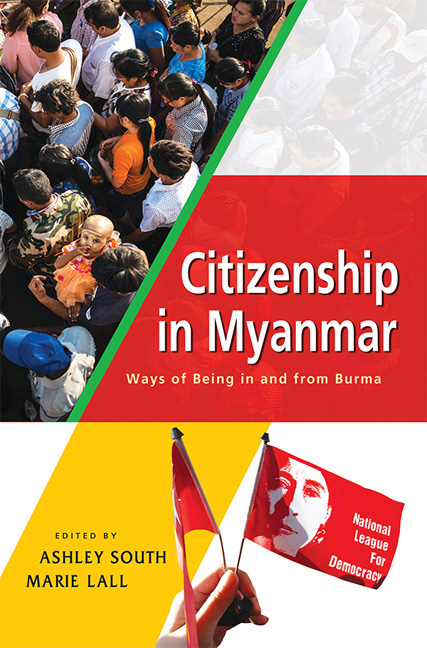Book contents
- Frontmatter
- Dedication
- Contents
- Foreword
- The Contributors
- Map of Myanmar
- Introduction
- 1 Ethnic Politics and Citizenship in History
- 2 Representation and Citizenship in the Future Integration of Ethnic Armed Actors in Myanmar/Burma
- Special Contribution: The Way Forward for Peace, Stability and Progress in Burma/Myanmar
- 3 National Political Dialogue and Practices of Citizenship in Myanmar
- 4 Citizenship and Minority Rights: The Role of “National Race Affairs” Ministers in Myanmar's 2008 Constitution
- Special Contribution: Karenni People at a Glance
- 5 Myanmar's Youth and the Question of Citizenship
- Special Contribution: I Am a Citizen of Myanmar
- 6 “The Value of Life”: Citizenship, Entitlement and Moral Legibility in Provincial Myanmar
- Special Contribution: How I Became Shan
- 7 Conflict and Mass Violence in Arakan (Rakine State): The 1942 Events and Political Identity Formation
- 8 Exploring the Issue of Citizenship in Rakhine State
- Special Contribution: Rohingya and Nationality Status in Myanmar
- 9 Myanmar's Other Muslims: The Case of the Kaman
- Special Contribution: Interview with P'doh Kweh Htoo Win
- Index
Special Contribution: The Way Forward for Peace, Stability and Progress in Burma/Myanmar
Published online by Cambridge University Press: 28 June 2018
- Frontmatter
- Dedication
- Contents
- Foreword
- The Contributors
- Map of Myanmar
- Introduction
- 1 Ethnic Politics and Citizenship in History
- 2 Representation and Citizenship in the Future Integration of Ethnic Armed Actors in Myanmar/Burma
- Special Contribution: The Way Forward for Peace, Stability and Progress in Burma/Myanmar
- 3 National Political Dialogue and Practices of Citizenship in Myanmar
- 4 Citizenship and Minority Rights: The Role of “National Race Affairs” Ministers in Myanmar's 2008 Constitution
- Special Contribution: Karenni People at a Glance
- 5 Myanmar's Youth and the Question of Citizenship
- Special Contribution: I Am a Citizen of Myanmar
- 6 “The Value of Life”: Citizenship, Entitlement and Moral Legibility in Provincial Myanmar
- Special Contribution: How I Became Shan
- 7 Conflict and Mass Violence in Arakan (Rakine State): The 1942 Events and Political Identity Formation
- 8 Exploring the Issue of Citizenship in Rakhine State
- Special Contribution: Rohingya and Nationality Status in Myanmar
- 9 Myanmar's Other Muslims: The Case of the Kaman
- Special Contribution: Interview with P'doh Kweh Htoo Win
- Index
Summary
OVERVIEW OF MYANMAR
Burma, or Myanmar, is a fortunate country in many ways. It has a warm and wet tropical climate, with adequate rainfall that encourages many kinds of plants to flourish. The land is blessed with fertile low-land plains, plateaus and high ground with gentle slopes, where many varieties of vegetables can be grown. In terms of natural resources, it has timber and bamboo forests; many waterfalls and rivers in the hills that have potential for generating hydroelectric power; underground there are mineral deposits, including gold, silver, copper, iron, and lead; there are gemstones such as rubies, sapphire and jade; and deposits of fossil fuels of coal, petroleum and natural gas.
It is also well positioned to benefit from international trade and commerce, having a long coastline with sites suitable for deep-sea ports, and archipelagos where all kinds of marine life thrives. With a land area of 260,000 square miles supporting a little more than 51 million inhabitants, the country does not suffer from a high population density. With all of these benefits, one would expect Burma to be an affluent nation, and at one time it did in fact have the highest living standard of Southeast Asian countries. However, from being the “rice bowl of Asia”, Burma is now listed as one of the world's Least Developed Countries (LDC). The following traces the main threads of Burma/Myanmar's recent history that have led to this situation.
The Union of Burma/Myanmar is inhabited by numerous ethnic groups, many with the characteristics of an independent nationality, such as having a substantial population living together in a defined area, with their own distinct language, literature, culture, custom and historical development. Prior to the British colonial era — and even during that era — some of these groups had their own kingdoms contemporaneously with the largest of the ethnic groups, the Burmans. In such a complex country, it is perhaps not surprising that there has been discord and armed conflict for nearly seventy years between the ethnic Burman (who have controlled the government) and the other ethnic nationalities. Almost all the ethnic nationalities have been in armed resistance at some time against successive central (Burman) governments. Some of the major ethnic groups being, alphabetically: Aka, Chin, Kachin, Karen, Karenni (Kayah), Kuki, Kokang, Lahu, Mon, Naga, Palaung (Ta'ang), Pa-oh, Rakhine (Arakanese), Shan, and Wa.
- Type
- Chapter
- Information
- Citizenship in MyanmarWays of Being in and from Burma, pp. 87 - 94Publisher: ISEAS–Yusof Ishak InstitutePrint publication year: 2017



